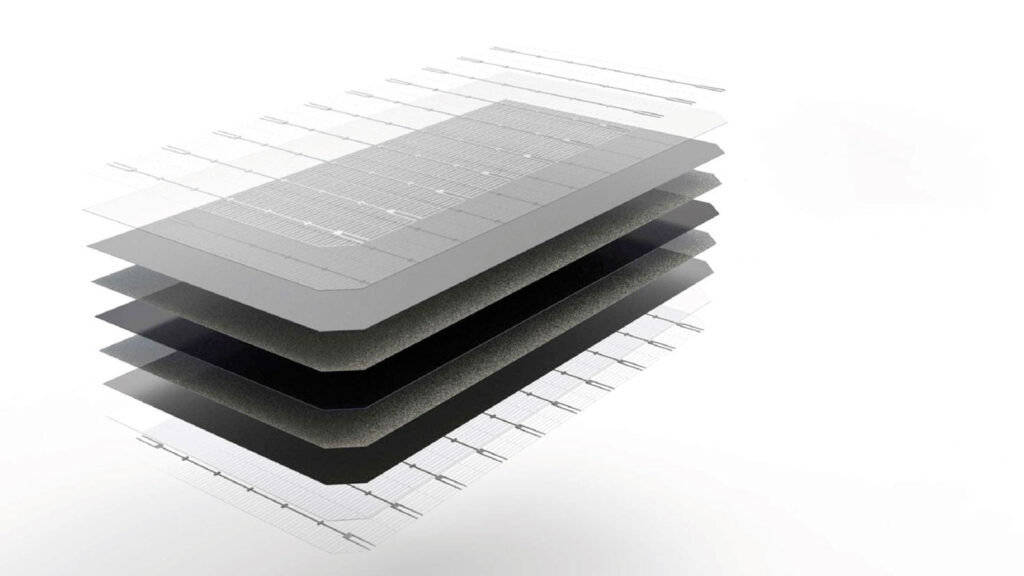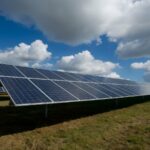Table of Contents
What are HJT Solar Panels?
Heterojunction(HJT) solar panel, also known as Silicon heterojunctions (SHJ) or Heterojunction with Intrinsic Thin Layer (HIT) solar panel, is a collection of HJT solar cells that leverage advanced photovoltaic technology. HJT cells combine the benefits of crystalline silicon with thin-film technologies. These cells are constructed based on an N-type monocrystalline silicon substrate, with non-doped amorphous silicon layers (i-a-Si:H) deposited on its surface. This unique structure enhances the performance and efficiency of the solar cells, which are then assembled into solar panels for practical applications.
The structure of HJT cells typically includes the following key components:
N-type Monocrystalline Silicon Substrate: The base of HJT panels is an N-type monocrystalline silicon wafer. N-type silicon is named for its majority carriers being electrons and typically offers higher carrier mobility and lower light-induced degradation (LID).
Intrinsic Amorphous Silicon Layer: On both sides of the monocrystalline silicon wafer, a layer of undoped (intrinsic) amorphous silicon is deposited. This intrinsic layer acts as a passivation layer, effectively reducing surface defects on the silicon wafer and thereby minimizing the recombination of charge carriers.
Doped Amorphous Silicon Layers: Outside the intrinsic layers, P-type and N-type amorphous silicon layers are added. These layers are doped (adding trace amounts of other elements) to change their conductivity, thus forming a P-N junction, which is crucial for solar cell power generation.
Transparent Conductive Oxide (TCO) Layer: The surface of the cell is often coated with a TCO material, like Indium Tin Oxide (ITO), to provide good light transmittance and electrical conductivity.
Metal Electrodes: To extract current from the cell, metal electrodes are added to the top and bottom. These electrodes are typically designed to be very thin to minimize the area that blocks sunlight.
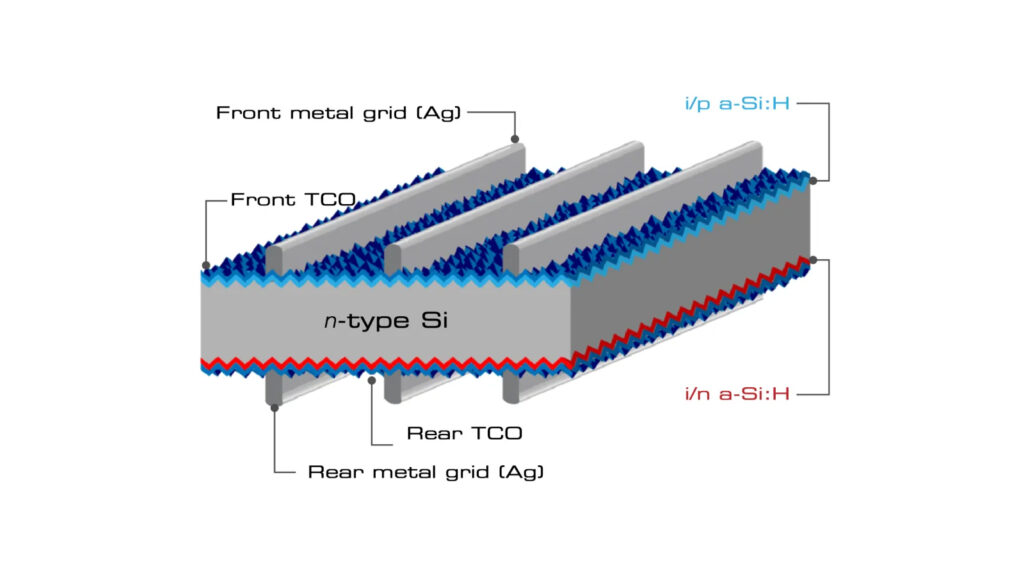
What are the Advantages of HJT Solar Cell Technology?
210mm High-Efficiency Cells
Utilizing HJT 210mm solar cells with high efficiency, its Transparent Conductive Oxide (TCO) film effectively passivates the interface defects of crystalline silicon and doped amorphous silicon, resulting in a photoelectric conversion efficiency of 25%. HJT solar cells are designed with an increased number of finer busbars, which effectively reduces shadowing caused by busbars and shortens the distance for current transmission. This design minimizes resistance, enhances current collection, and consequently improves the overall power generation efficiency. Additionally, the use of numerous ultra-fine busbars contributes to the reduction of micro-cracks and busbar breakage, thereby increasing the flexibility and reliability of the cells.
High Bifacial Rate
HJT solar cells feature a unique design with symmetrical structures on both front and back sides, paired with mesh plates. This configuration significantly boosts their bifacial electricity generation capabilities. Remarkably, these cells achieve over 95% power generation efficiency on the rear side, marking a substantial improvement in overall energy production.
The innovative transparent dual-glass design aids in allowing light to penetrate through the gaps between solar cells, thereby enhancing rear-side electricity generation and increasing the return on investment. This feature is especially beneficial for applications such as fences, carports, and canopies, where dual-sided power generation is crucial.
When compared to PERC and TopCon technologies, heterojunction cells with high bifacial rates can generate more than 30% additional power. This impressive enhancement in energy output makes heterojunction solar cells particularly effective for installations where both sides of the panel are exposed to direct or reflected sunlight, maximizing energy harnessing.
Excellent Low-Light Performance
HJT cells integrate i-a-SiH thin films between crystalline silicon and doped amorphous silicon. The undoped hydrogenated amorphous silicon layer (i-a-Si:H) serves to passivate defects present on the crystalline silicon surface. This passivation process reduces the recombination of charge carriers at the interface, resulting in an increased open-circuit voltage (Voc), leading to high open-circuit voltage (750mV). This elevated Voc facilitates higher voltage output even in low-light conditions, achieving the inverter’s startup voltage more quickly and significantly extending the period of electricity generation into the early morning and evening hours, thus maximizing the daily energy yield.
Low Temperature Coefficient
In the warm and sunny conditions typical of European summers, Heterojunction (HJT) solar panels stand out as the superior choice. Their low temperature coefficient of -0.24%/°C, compared to PERC and TOPCon cells, ensures stable and efficient power generation, even in higher temperatures. This attribute makes HJT solar panels particularly adept for use during the summer months in Europe, where maximizing solar energy efficiency is crucial. The minimized power loss in high-temperature environments demonstrates their robustness and reliability, positioning them as a preferred option for solar energy systems in Europe’s varied summer weather. To learn more about the temperature coefficient of solar panels, click the button below to read the article!
Low Degradation
HJT cells eliminate the possibility of electronic issues on the cell surface, preventing Light-Induced Degradation (LID) and Light and Elevated Temperature-Induced Degradation (LeTID) effects. The TCO film layer, endowed with conductive properties, prevents the generation of surface polarization, structurally mitigating the risk of Potential-Induced Degradation (PID) decay.
The power generation capacity of heterojunction modules will experience no more than a 12.6% decay over 30 years, ensuring a stable power generation throughout the life cycle of HJT solar panels.
Full Black with No Colour Difference
Due to the characteristics of HJT cell technology, the color consistency between the front and back of HJT solar panels is maintained without any differences, creating a visually appealing and coordinated effect, establishing it as the preferred choice for full black solar panels and also as the best choice for dark-coloured roofs in Europe.
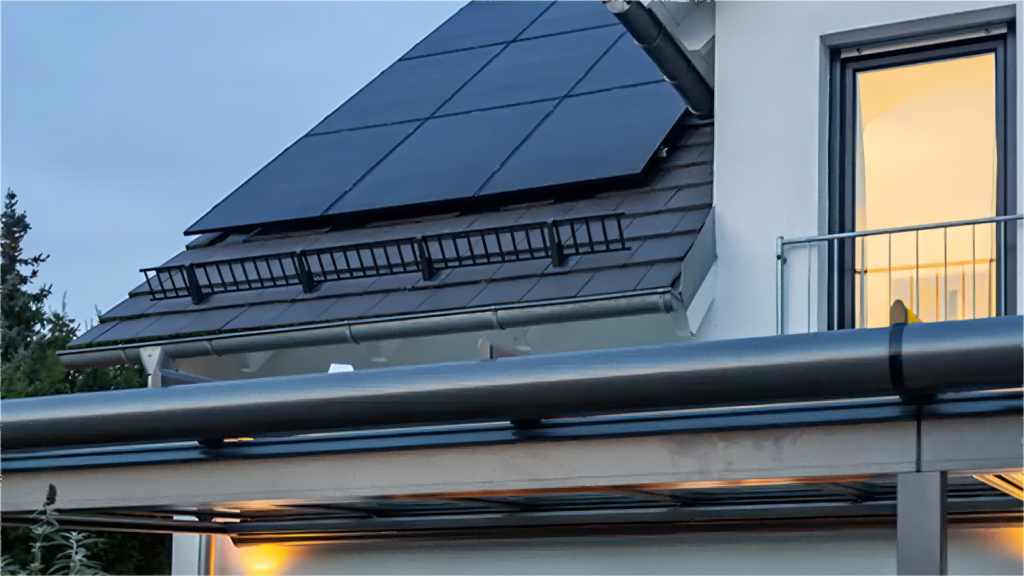
High Reliability
The HJT solar panel is equipped with weather-resistant, corrosion-resistant, and wear-resistant double-sided glass and POE encapsulation, providing a 30-year guarantee for both product and performance. The low-temperature process and no-cut solar cells technology make the cells less damaged, highly flexible, less occurrence of microcracks, and easy to transport and install.
What are the Technical Advantages of HJT Compared to PERC and TOPCon?
When comparing Heterojunction Technology (HJT), Tunnel Oxide Passivated Contact (TOPCon), and Passivated Emitter Rear Cell (PERC) solar panels across various technical parameters, the following data highlights the advantages of HJT:
In terms of bifaciality, HJT solar panels lead with a 95% efficiency, surpassing TOPCon at 85% and PERC at 70%. This higher bifaciality indicates superior sunlight absorption from both the front and back sides, maximizing overall energy capture.
Power generation efficiency is another area where HJT excels, boasting a 22.87% efficiency compared to TOPCon at 22.28% and PERC at 21.2%. This higher efficiency underscores HJT’s superior ability to convert sunlight into electricity, resulting in enhanced overall performance.
HJT solar panels exhibit lower first-year power degradation at 1%, outperforming TOPCon at 1.5% and PERC at 2%. This suggests that HJT technology provides better initial stability in power output.
Moreover, from the second year onward, HJT solar panels showcase an average annual power degradation of 0.35%, demonstrating superior long-term stability compared to TOPCon (0.4%) and PERC (0.45%).
In terms of temperature coefficient, HJT solar panels stand out with a lower value of -0.243%/°C, indicating reduced sensitivity to temperature variations compared to TOPCon (-0.32%/°C) and PERC (-0.35%/°C). This characteristic contributes to the consistent and reliable power generation of HJT solar panels across diverse environmental conditions.
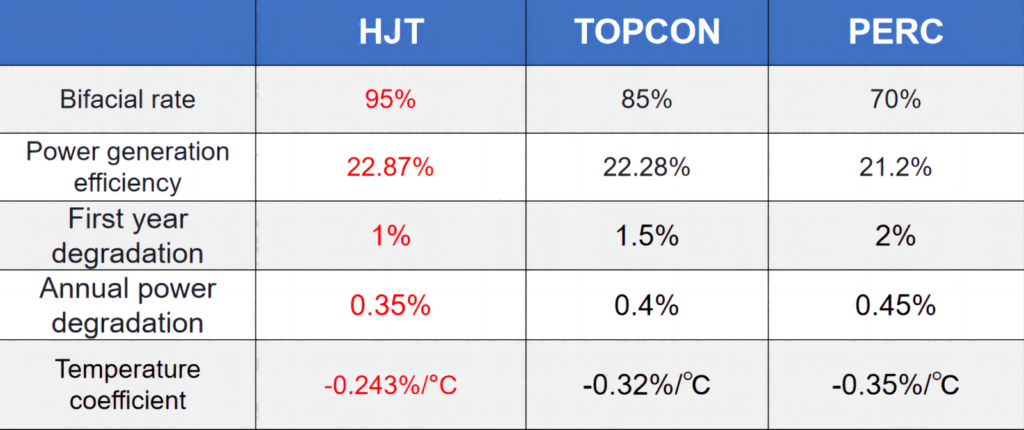
Discover the forefront of renewable energy innovation with Maysun Solar’s HJT solar panels. Harnessing the unparalleled benefits of Heterojunction Technology (HJT), our panels represent a leap forward in solar power efficiency. These panels are engineered with superior heterojunction technology, delivering consistent, high voltage output even under low-light conditions. Their low temperature coefficient (-0.243%/℃) translates to sustained performance in hotter climates, prolonging effective energy generation. Boasting an impressive bifacial rate (95%), Maysun Solar’s HJT panels maximize solar energy absorption, significantly boosting your photovoltaic system’s energy yield. For a deeper insight into the capabilities of HJT solar panels, click the button below and embark on a journey to cleaner, more efficient energy solutions!



In What Scenarios are HJT Solar Panels More Suitable?
Heterojunction (HJT) solar panels are highly suitable for various scenarios, including but not limited to agricultural photovoltaics, carport photovoltaics, rooftop photovoltaics, and various other applications.
Agricultural Photovoltaics: HJT solar panels are particularly well-suited for agricultural photovoltaic scenarios, showcasing high bifacial efficiency and outstanding performance under low-light conditions. This allows the panels to maintain efficient electricity generation in changing weather and lighting conditions. Their low-temperature coefficient characteristic means that even in high-temperature environments experienced in agricultural regions during the day, HJT solar panels can minimize performance losses. Additionally, the panels’ resistance to PID and LID effects ensures long-term stability and reliability, making them an ideal choice for agricultural applications with sustained electricity generation needs. Moreover, they can seamlessly integrate into agricultural infrastructure, such as the tops of greenhouses and agricultural sheds, providing shade and achieving the dual objectives of agricultural production and clean energy.
Carport Photovoltaics: HJT solar panels also excel in carport photovoltaic applications, benefiting primarily from their excellent bifacial efficiency and low-light performance. In environments like carports, solar panels are often subject to shading from surrounding structures, but HJT panels can effectively capture and convert sunlight, maintaining good electricity generation efficiency even under partial shading conditions. The efficient utilization of scattered and reflected light by HJT panels allows them to maintain outstanding electricity generation performance in variable lighting conditions in urban environments, such as carports. These characteristics make HJT solar panels an ideal choice for fully utilizing solar resources in urban settings like carports.
Rooftop Photovoltaics: Rooftop photovoltaics demand space efficiency and long-term performance, and the durability, high efficiency, and minimal degradation characteristics of HJT solar panels make them an ideal choice for these applications. They withstand various environmental pressures, including humidity and UV exposure, making them suitable for regions with fluctuating weather conditions.
Regions with High Summer Temperatures, such as Southern Europe: HJT solar panels exhibit excellent temperature coefficients (approximately -0.24%/°C), meaning they experience less efficiency loss in hot conditions compared to traditional photovoltaic panels. This makes them particularly suitable for high temperature environments.
Regions with Poor Lighting Conditions, such as Northern Europe: HJT solar panels are renowned for their outstanding low-light performance, including on overcast days or during early mornings and late afternoons. This is attributed to their high open-circuit voltage and effective light absorption capabilities. In addition, the dual-sided electricity generation nature of HJT solar panels makes them especially useful in snowy environments in Europe, utilizing reflected light from the ground.
Overall, HJT solar panels are suitable for a variety of scenarios, meeting specific requirements for agriculture, carports, rooftops, and diverse climatic and geographical environments. They stand as a versatile and robust energy solution.
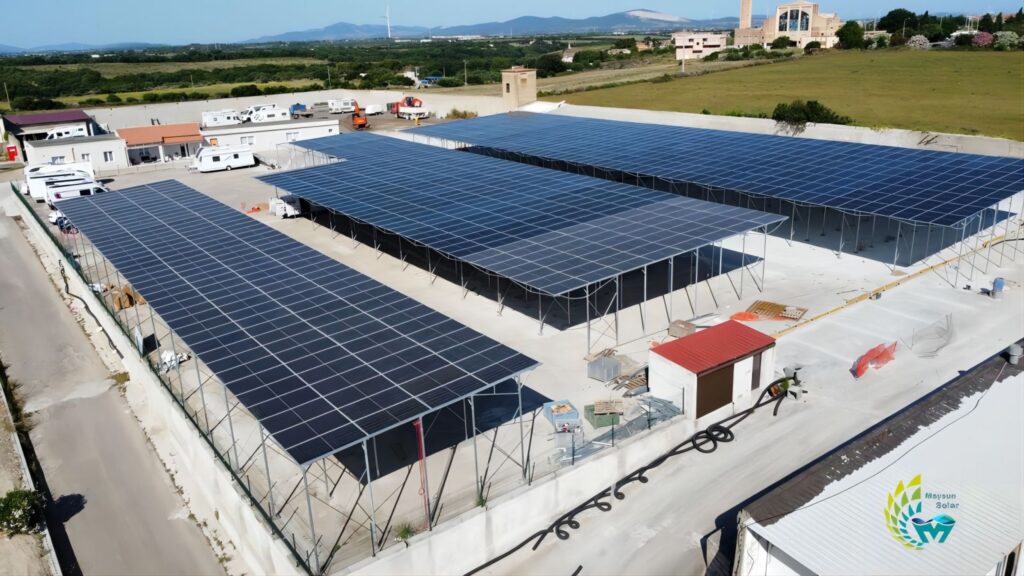
Since 2008, Maysun Solar has been dedicated to producing high-quality photovoltaic modules that contribute to combating climate change. Our advanced technology in IBC, HJT, TOPCon, and balcony solar panels ensures exceptional performance and reliability, capable of withstanding harsh weather conditions for long-term operation. We have established offices and warehouses in multiple countries and built lasting partnerships with top installers to provide comprehensive support. For the latest quotes or any inquiries related to photovoltaics, feel free to reach out to us—we’re here to help!

Empowering Factories with Solar Energy A Strategic Tool for Controlling Production Electricity Costs
Commercial and industrial solar is becoming a key solution for factories to reduce electricity costs and hedge against price fluctuations. This article systematically analyzes its deployment models, cost advantages, and sustainable value pathways.

How Businesses Can Offset Carbon Taxes with Solar Power
This article analyzes the latest carbon tax policies and photovoltaic deduction strategies, helping European businesses legally reduce taxes, increase profits through solar investment, and achieve a win-win situation for both economy and environment.

Forecast and Response: Seizing the Next Decade’s Growth Dividend in Europe’s Commercial and Industrial Photovoltaics Market
Maysun Solar analyzes the growth trends of commercial and industrial photovoltaics in Europe over the next ten years, from policies and ESG to technological innovation, helping companies seize the initiative in the energy transition.

How to Calculate Solar System ROI and Optimize Long-Term Returns?
Solar power is becoming a key solution for businesses to reduce costs and improve efficiency. Accurately calculating ROI and optimizing long-term returns are essential to maximizing investment value.

Will Agrivoltaics Affect Crop Growth?
Agrivoltaics combines solar energy and agriculture to reduce up to 700 tons of CO₂ per MW, improve water use, and boost crop growth for sustainable farming.

6.5 Billion Loss Hits Photovoltaics: Reshaping or Elimination?
In 2025, the photovoltaic market may see a turnaround as some companies take early action. A €6.5 billion loss is driving businesses to explore new growth areas like energy storage and hydrogen. Which giants will break through? Industry transformation is accelerating!

